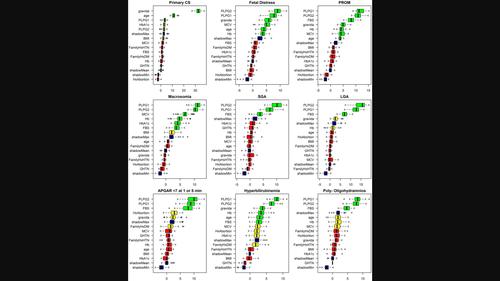当前位置:
X-MOL 学术
›
J. Diabetes Investig.
›
论文详情
Our official English website, www.x-mol.net, welcomes your feedback! (Note: you will need to create a separate account there.)
Post‐load glucose is a stronger predictor of adverse pregnancy outcomes than first‐trimester HbA1c in women without gestational diabetes
Journal of Diabetes Investigation ( IF 3.2 ) Pub Date : 2024-03-08 , DOI: 10.1111/jdi.14181 Shahin Keshtkar Rajabi 1 , Elham Toghraee 2 , Golnoosh Nejatipour 3
Journal of Diabetes Investigation ( IF 3.2 ) Pub Date : 2024-03-08 , DOI: 10.1111/jdi.14181 Shahin Keshtkar Rajabi 1 , Elham Toghraee 2 , Golnoosh Nejatipour 3
Affiliation

|
Aims/IntroductionA debate exists on the relation of adverse pregnancy outcomes with glycemic levels in early pregnancy. We aimed to investigate the association of maternal characteristics including post‐load glucose and first‐trimester HbA1c test results with adverse pregnancy outcomes in women without gestational diabetes mellitus.Materials and MethodsA dataset (January 2011 and September 2017) from a hospital prenatal clinic was explored to find the important predictors of adverse pregnancy outcomes using maternal characteristics and glucose assessments in mothers without gestational diabetes. We used two machine learning algorithms to capture nonlinearity in selecting important maternal characteristics and developed predictive models for each outcome. In total, 1,618 pregnant women were included in the analytic dataset with a mean (SD) age of 26.8 (3.5) years and gravida of 1.7 (0.9).ResultsImportant associations were detected between maternal features and primary cesarean section, fetal distress, premature rupture of membranes, macrosomia, small or large for gestational age, APGAR <7 at 1 or 5 min, hyperbilirubinemia, and poly‐ or oligo‐hydramnios. Overall, the predictive models showed good performance and large areas under the curves (0.732, 0.765, 0.646, 0.651, 0.730, 0.646, 0.684, 0.716, and 0.678, respectively). Specifically, they had high positive likelihood ratios.ConclusionsHigh glucose levels were associated with adverse pregnancy outcomes. Post‐load glucose was the most reliable test for predicting the outcomes. Overall, fasting blood sugar was of more predictive value than HbA1c. Our study showed that further research should account for the nonlinearity and interactions inherent in the data.
中文翻译:

对于无妊娠糖尿病的女性,负荷后血糖比妊娠早期 HbA1c 更能预测不良妊娠结局
目的/简介关于不良妊娠结局与妊娠早期血糖水平的关系存在争议。我们的目的是调查母亲特征(包括负荷后血糖和妊娠早期 HbA1c 测试结果)与无妊娠期糖尿病的女性不良妊娠结局之间的关联。材料和方法对来自医院产前诊所的数据集(2011 年 1 月和 2017 年 9 月)进行了探索利用母亲特征和没有妊娠糖尿病的母亲的血糖评估来寻找不良妊娠结局的重要预测因素。我们使用两种机器学习算法来捕获选择重要母亲特征时的非线性,并为每个结果开发了预测模型。分析数据集中总共纳入了 1,618 名孕妇,平均 (SD) 年龄为 26.8 (3.5) 岁,妊娠年龄为 1.7 (0.9)。结果发现母亲特征与初次剖宫产、胎儿窘迫、早破之间存在重要关联胎膜缺陷、巨大儿、小于胎龄或大于胎龄、1 分钟或 5 分钟 APGAR <7、高胆红素血症以及羊水过多或过少。总体而言,预测模型表现出良好的性能和较大的曲线下面积(分别为 0.732、0.765、0.646、0.651、0.730、0.646、0.684、0.716 和 0.678)。具体来说,它们具有很高的阳性似然比。结论高血糖水平与不良妊娠结局相关。负荷后血糖是预测结果的最可靠的测试。总体而言,空腹血糖比 HbA1c 更具预测价值。我们的研究表明,进一步的研究应该考虑数据固有的非线性和相互作用。
更新日期:2024-03-08
中文翻译:

对于无妊娠糖尿病的女性,负荷后血糖比妊娠早期 HbA1c 更能预测不良妊娠结局
目的/简介关于不良妊娠结局与妊娠早期血糖水平的关系存在争议。我们的目的是调查母亲特征(包括负荷后血糖和妊娠早期 HbA1c 测试结果)与无妊娠期糖尿病的女性不良妊娠结局之间的关联。材料和方法对来自医院产前诊所的数据集(2011 年 1 月和 2017 年 9 月)进行了探索利用母亲特征和没有妊娠糖尿病的母亲的血糖评估来寻找不良妊娠结局的重要预测因素。我们使用两种机器学习算法来捕获选择重要母亲特征时的非线性,并为每个结果开发了预测模型。分析数据集中总共纳入了 1,618 名孕妇,平均 (SD) 年龄为 26.8 (3.5) 岁,妊娠年龄为 1.7 (0.9)。结果发现母亲特征与初次剖宫产、胎儿窘迫、早破之间存在重要关联胎膜缺陷、巨大儿、小于胎龄或大于胎龄、1 分钟或 5 分钟 APGAR <7、高胆红素血症以及羊水过多或过少。总体而言,预测模型表现出良好的性能和较大的曲线下面积(分别为 0.732、0.765、0.646、0.651、0.730、0.646、0.684、0.716 和 0.678)。具体来说,它们具有很高的阳性似然比。结论高血糖水平与不良妊娠结局相关。负荷后血糖是预测结果的最可靠的测试。总体而言,空腹血糖比 HbA1c 更具预测价值。我们的研究表明,进一步的研究应该考虑数据固有的非线性和相互作用。



























 京公网安备 11010802027423号
京公网安备 11010802027423号